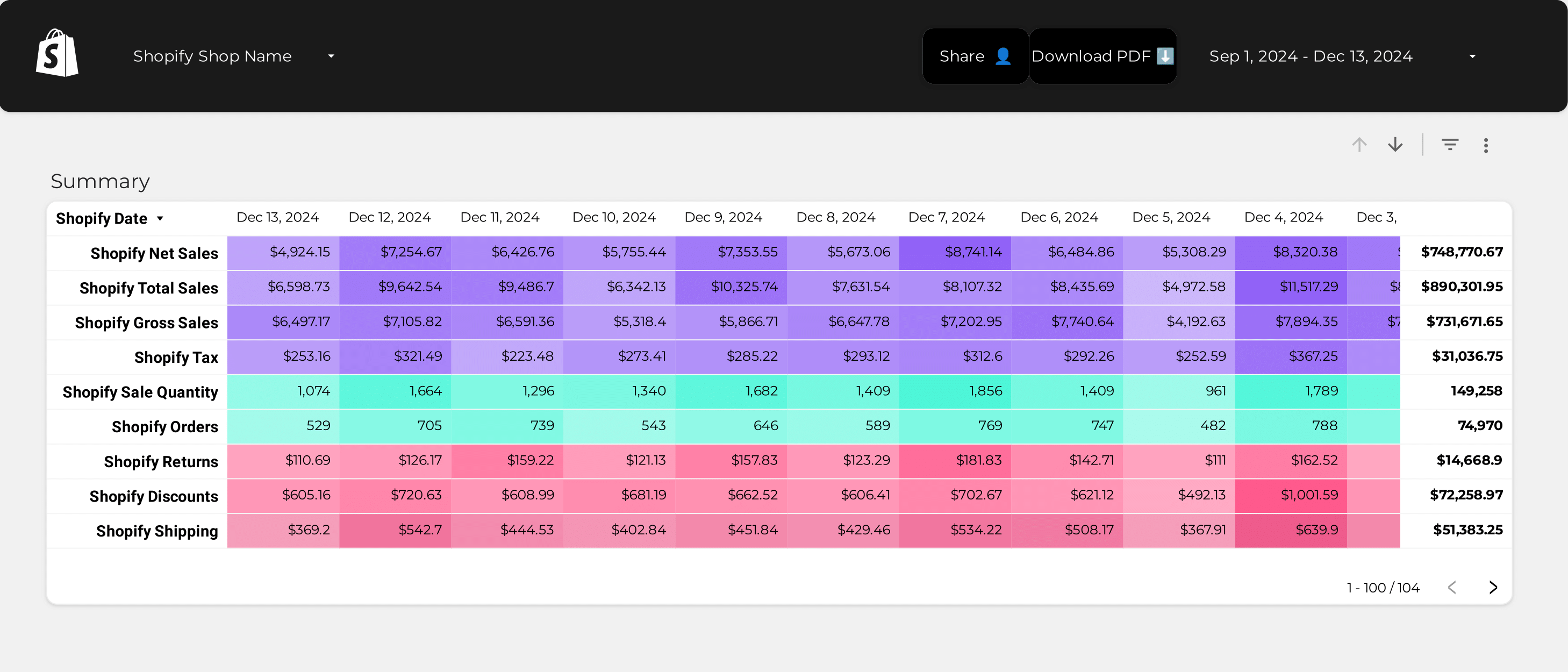
Shopify KPIs Dashboard template
The Shopify KPIs Dashboard Template is designed for e-commerce businesses using Shopify to track and analyze their performance metrics. This dashboard provides a clear view of your store’s critical performance indicators, enabling data-driven decision-making.
With this template, you can monitor:
- Sales Performance: Track total sales, average order value, and conversion rates.
- Customer Insights: Analyze customer acquisition, retention rates, and lifetime value.
- Product Analytics: Evaluate product performance, including bestsellers and inventory levels.
- Traffic Sources: Understand where your traffic is coming from and which channels are most effective.
Utilize this dashboard to maintain a comprehensive overview of your Shopify store’s performance, ensuring you stay informed and responsive to market trends.
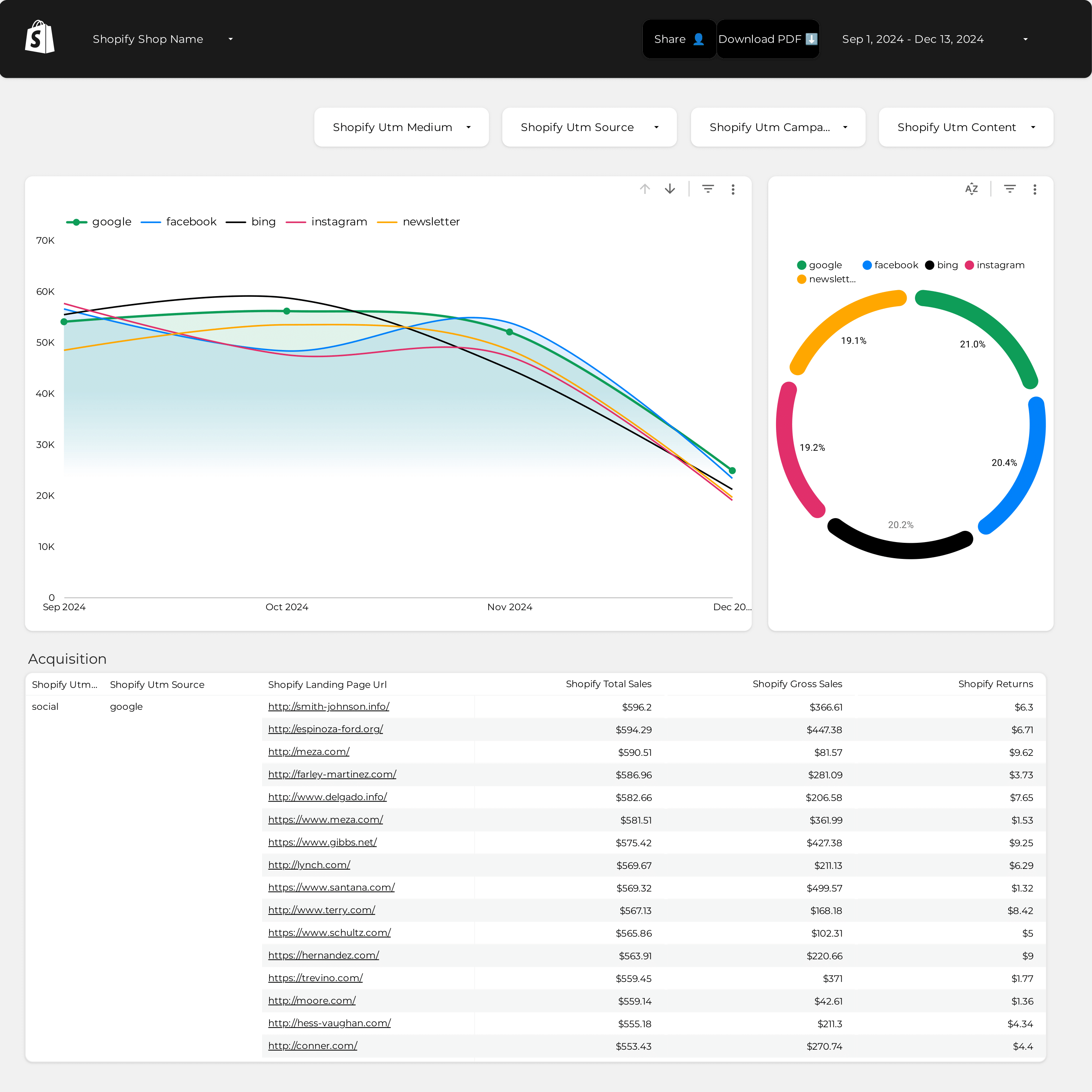
Shopify Attribution Dashboard template
The Shopify Attribution Dashboard template is designed for e-commerce businesses using Shopify to track and analyze their marketing efforts. This dashboard provides a detailed view of how different marketing channels contribute to sales and customer acquisition.
With this template, you can:
- Track PPC Campaigns: Monitor the performance of your pay-per-click campaigns across various platforms.
- Analyze Attribution Models: Understand the impact of different attribution models on your sales data.
- Visualize Customer Journeys: Gain insights into the paths customers take before making a purchase.
- Measure ROI: Calculate the return on investment for each marketing channel.
This dashboard integrates seamlessly with Shopify, providing real-time data and analytics to help you make informed decisions about your marketing strategies.
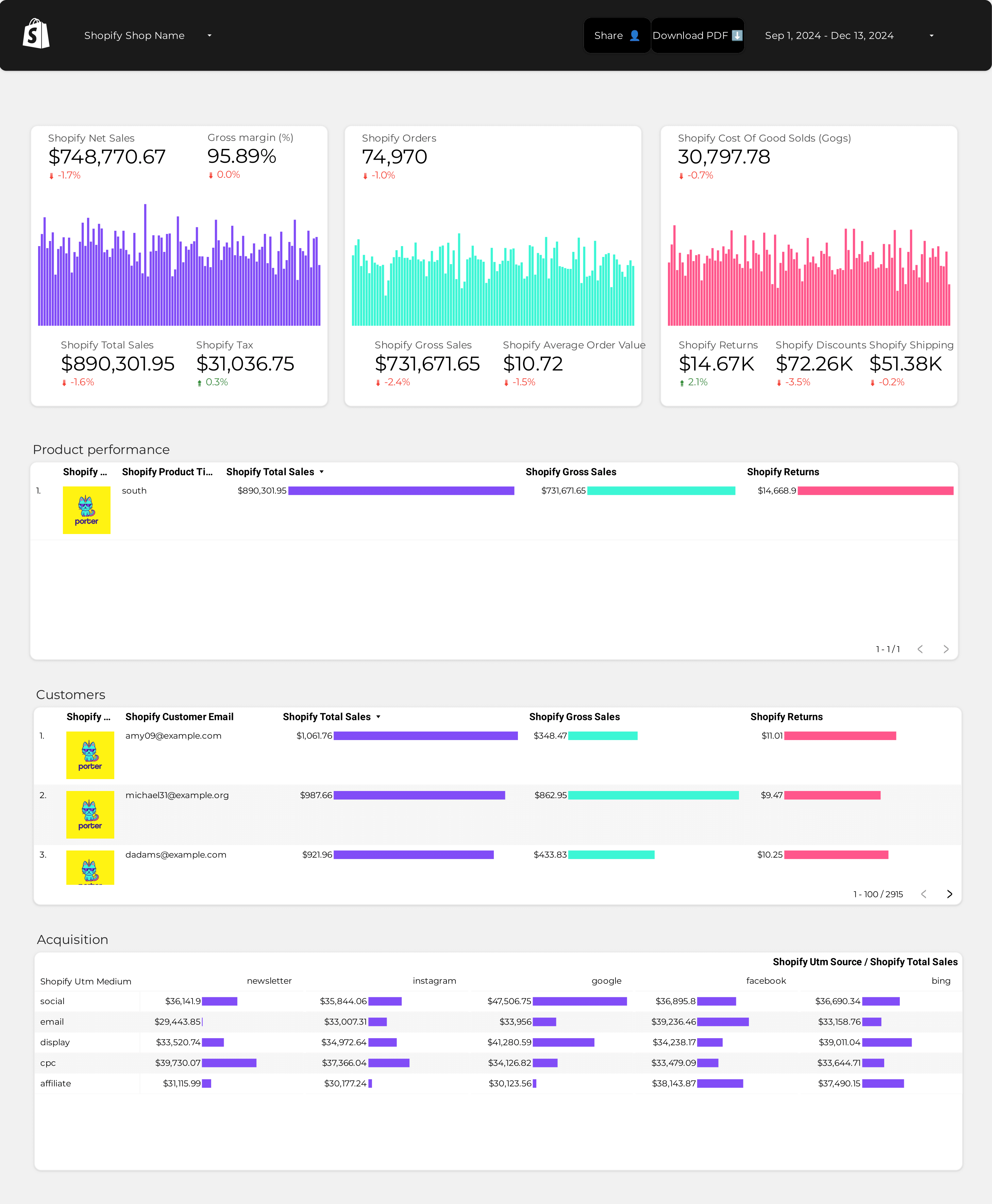
Shopify Dashboard template
The Shopify Dashboard Template is designed to provide a streamlined overview of your e-commerce operations. This template integrates seamlessly with Shopify, offering a centralized hub for monitoring and managing your online store’s performance.
With this dashboard, you can:
- Track Sales Data: Access real-time sales figures and analyze trends over time.
- Monitor Inventory Levels: Keep an eye on stock availability to ensure timely restocking and avoid stockouts.
- Analyze Customer Behavior: Gain insights into customer purchasing patterns and preferences.
- Review Marketing Campaigns: Evaluate the effectiveness of your marketing efforts and adjust strategies accordingly.
This template is an essential tool for any Shopify store owner looking to maintain a competitive edge in the e-commerce landscape.
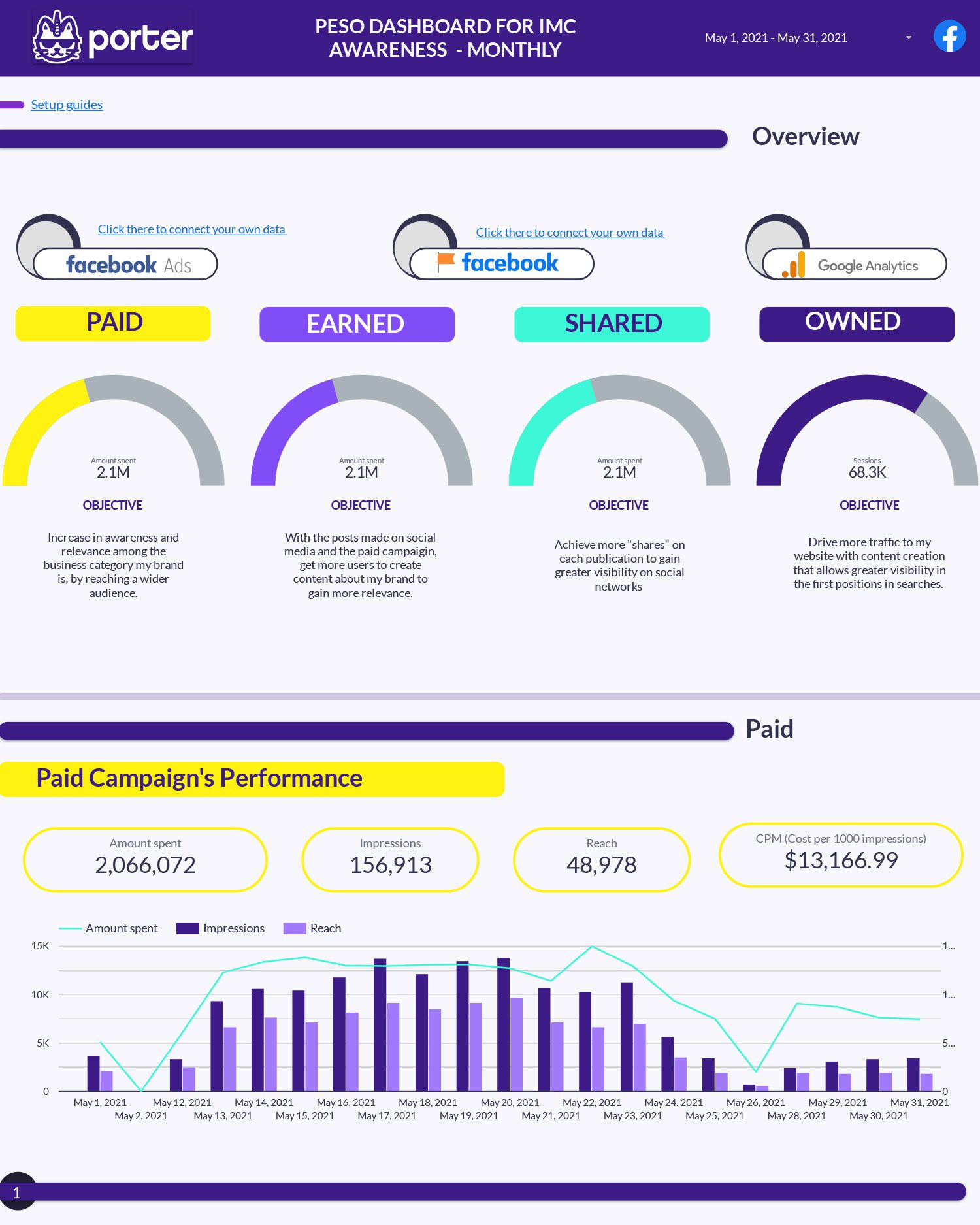
Peso model Dashboard template
The PESO Model Dashboard template provides a structured approach to analyzing and managing your social media and digital marketing efforts. This template integrates various platforms and metrics to offer a holistic view of your marketing performance.
Social Media Insights are gathered from platforms like Instagram, Facebook, LinkedIn, Pinterest, and TikTok. These insights help in understanding audience engagement and content reach.
- Instagram Insights: Track follower growth, engagement rates, and content interactions.
- Facebook Insights: Analyze page views, post reach, and audience demographics.
- LinkedIn Pages: Monitor page followers, post performance, and professional engagement.
- Pinterest: Evaluate pin impressions, saves, and audience trends.
- TikTok: Assess video views, likes, and follower activity.
E-commerce Metrics are integrated to track sales conversions and customer interactions across social platforms, providing a direct link between social media efforts and revenue generation.
SEO Performance is monitored to ensure that content is optimized for search engines, driving organic traffic to your digital assets.
This dashboard template is designed for marketers looking to streamline their reporting process and gain actionable insights from their digital marketing activities.
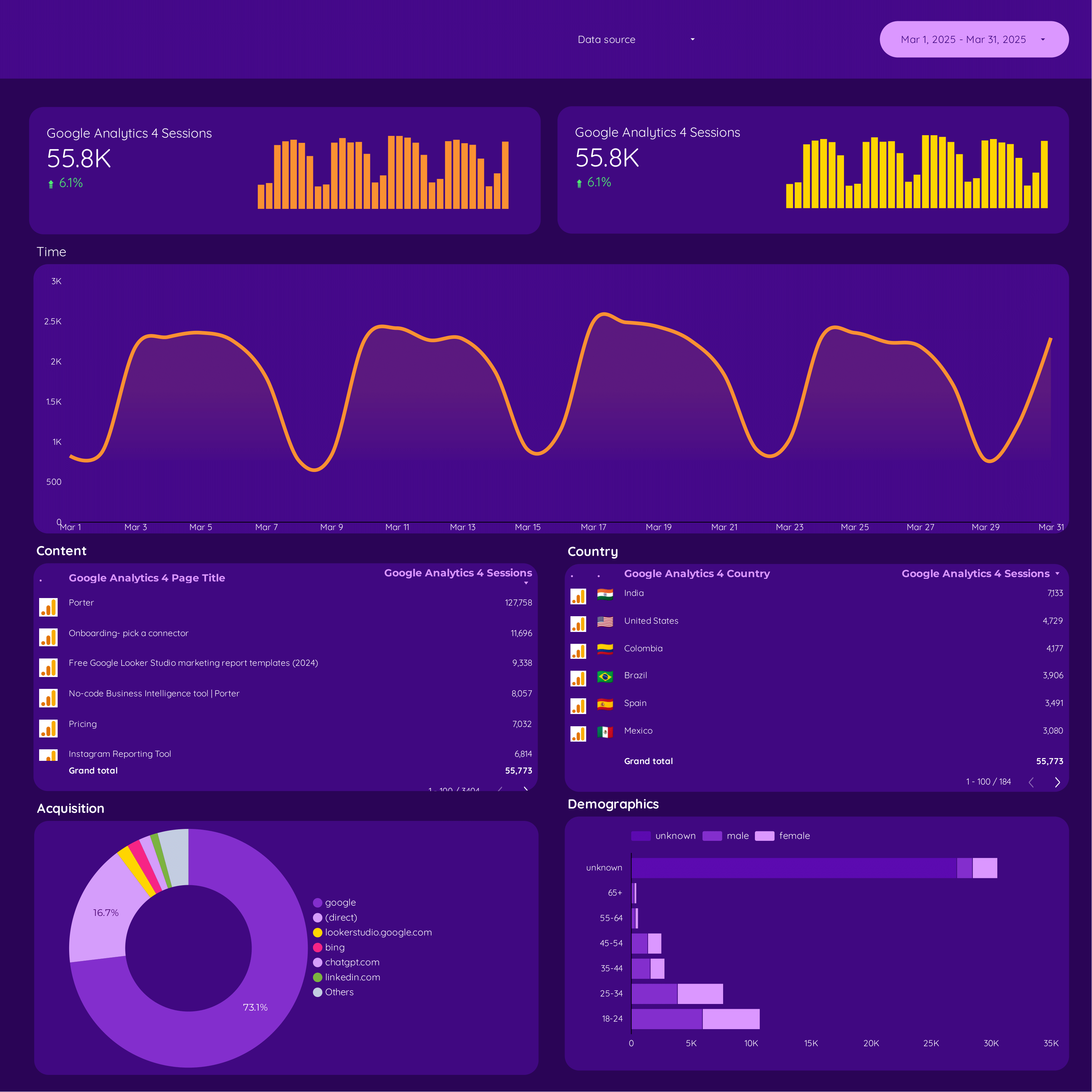
Google Analytics 4 E-commerce Dashboard template
The Google Analytics 4 E-commerce Dashboard template is designed for businesses using Shopify to track and analyze their online store’s performance. This dashboard provides a detailed view of your e-commerce data, allowing you to monitor and optimize your store’s performance effectively.
With this template, you can access a variety of metrics and dimensions, including:
- Sales Performance: Track total revenue, average order value, and conversion rates.
- Customer Behavior: Analyze user engagement, session duration, and bounce rates.
- Traffic Sources: Identify where your visitors are coming from, including organic search, paid ads, and social media.
- Product Insights: Review product performance, including top-selling items and product views.
This dashboard leverages the capabilities of Google Analytics 4 to provide real-time data and insights, helping you make informed decisions about your e-commerce strategy.
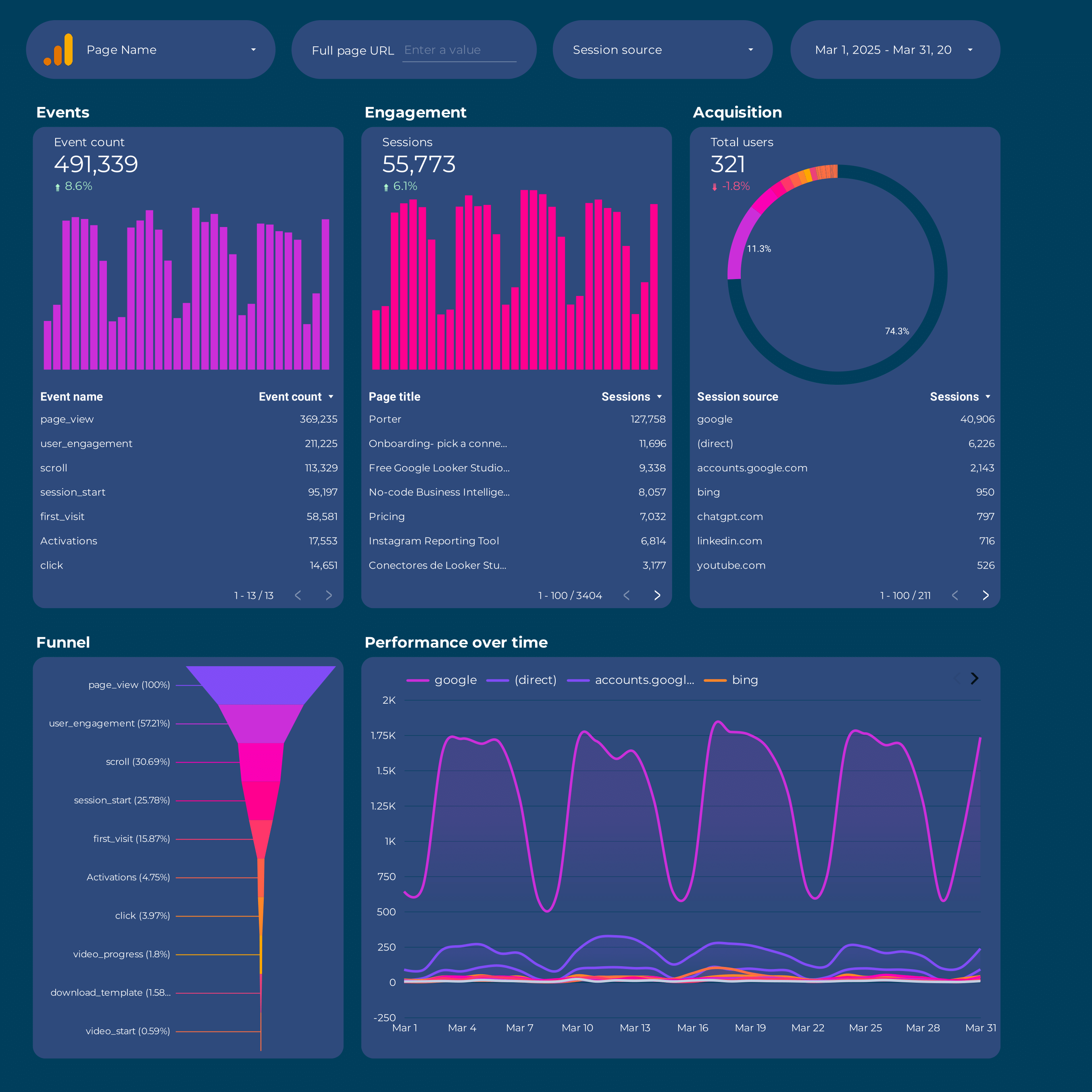
Google Analytics 4 Dashboard template
The Google Analytics 4 Dashboard Template is designed for marketing professionals and e-commerce businesses seeking to leverage website data effectively. This template provides a structured view of your Google Analytics 4 data, focusing on essential metrics and insights.
With this dashboard, you can:
- Track user acquisition and understand which channels drive the most traffic.
- Analyze user behavior to identify popular pages and content.
- Monitor conversion rates to assess the performance of marketing campaigns.
- Evaluate e-commerce metrics such as revenue, average order value, and product performance.
This template is tailored for those who need to make data-driven decisions based on real-time analytics and customizable reports.
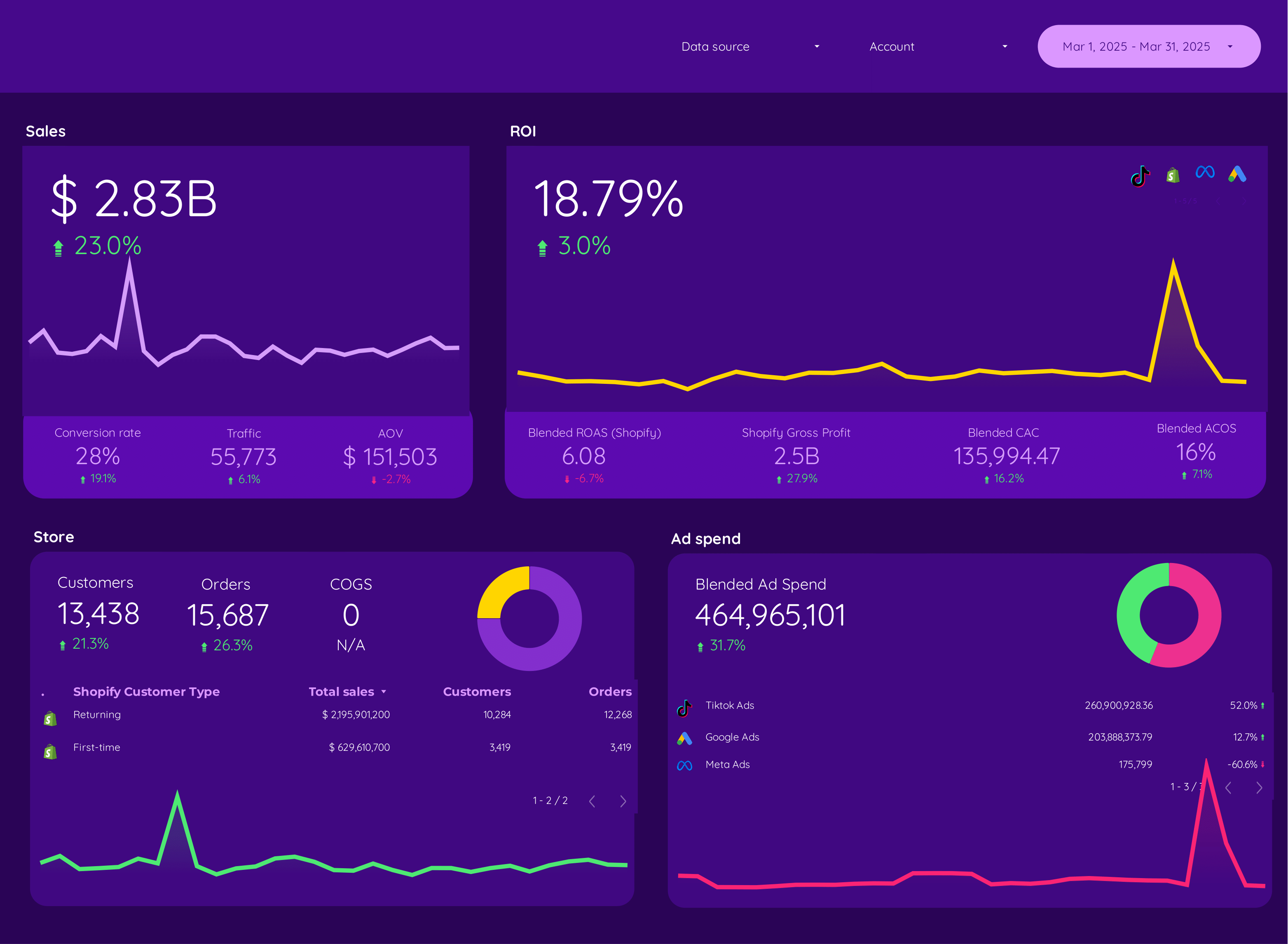
E-commerce Dashboard template
The E-commerce Dashboard Template is designed to provide a centralized view of your online business performance. It integrates data from multiple platforms to offer a holistic view of your marketing and sales efforts.
With this dashboard, you can track and analyze data from:
- Google Analytics 4 for website traffic and user behavior insights.
- Shopify for sales and product performance metrics.
- Facebook Ads and Instagram Insights for social media advertising performance.
- Google Ads for search engine marketing analytics.
- Klaviyo for email marketing campaign results.
- TikTok Ads for video marketing effectiveness.
This template allows you to monitor PPC campaigns and assess the impact of your advertising spend across different channels. By consolidating data from Facebook Insights and other platforms, you can make informed decisions to optimize your marketing strategies.
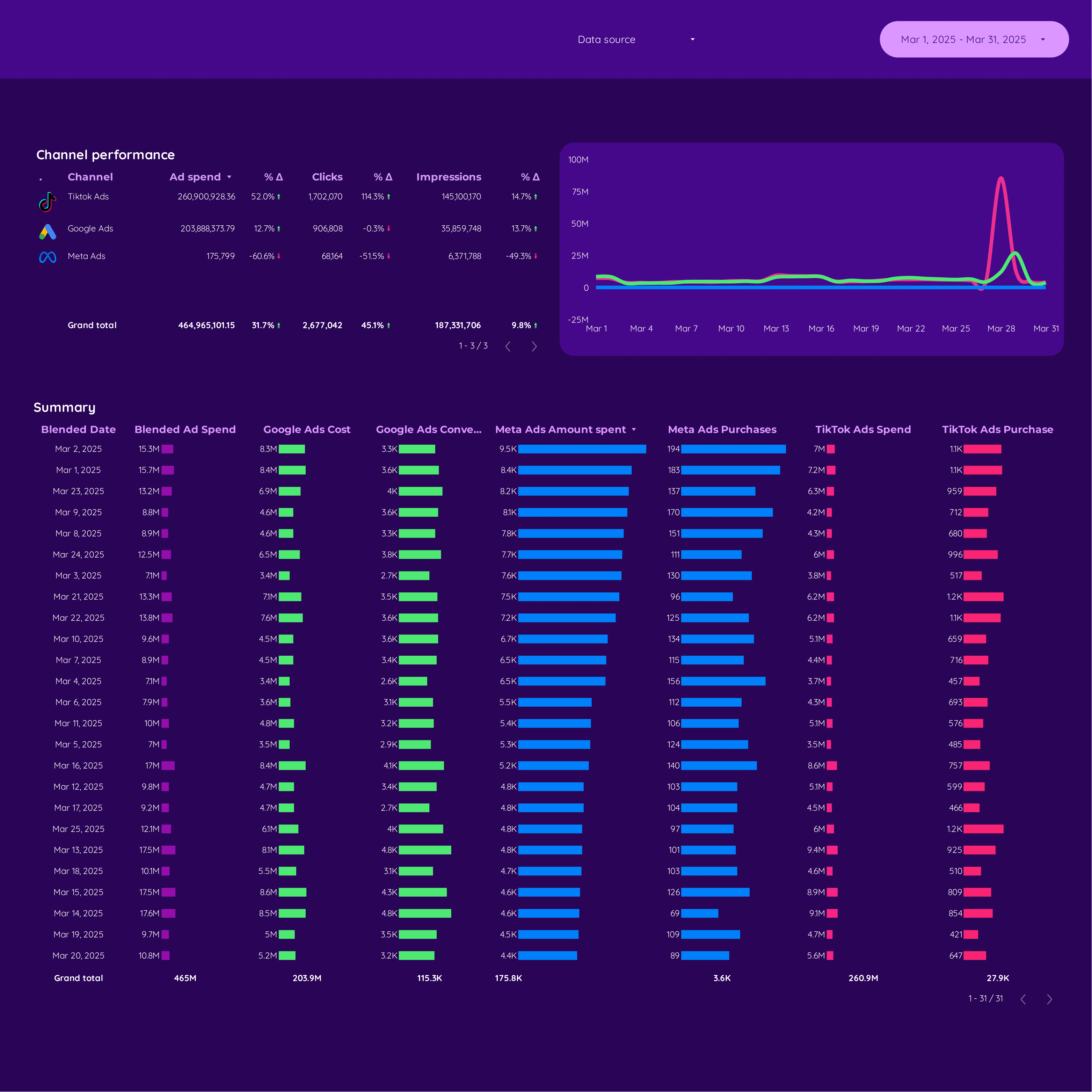
Cross-channel Dashboard template
The Cross-channel Dashboard template is designed for PPC and Marketing professionals in the E-commerce and B2B sectors. This template provides a centralized view of your advertising efforts across multiple platforms.
Track and analyze performance from:
- Facebook Ads
- Google Ads
- LinkedIn Ads
- TikTok Ads
Utilize this dashboard to monitor campaign metrics, compare platform performance, and make data-driven decisions. The template supports integration with various ad platforms, allowing for real-time data synchronization and reporting.
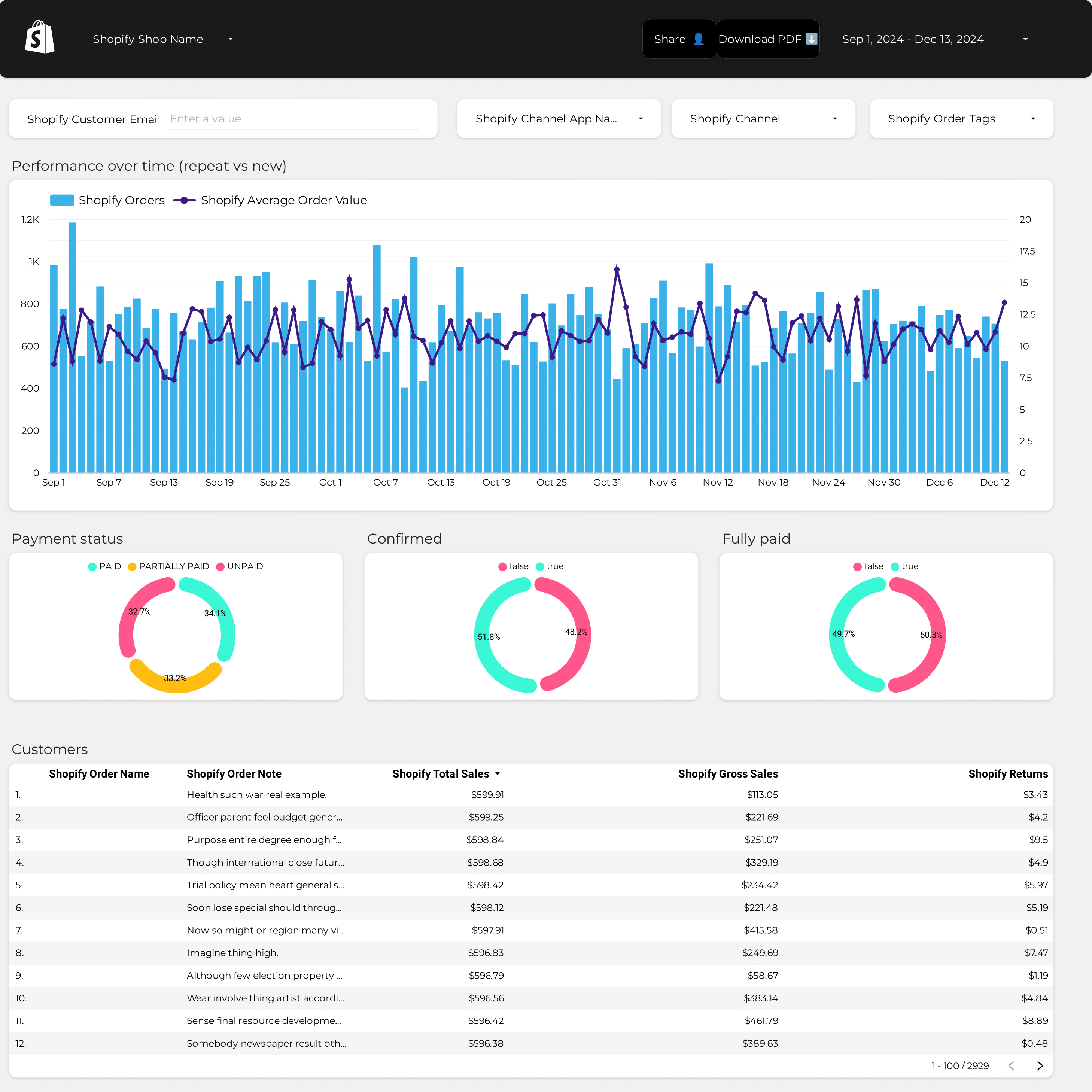
AOV Dashboard template
The AOV Dashboard Template is designed for e-commerce businesses using Shopify. This template provides a structured view of your Average Order Value (AOV) metrics, enabling data-driven decision-making.
Features include:
- Real-time Data Integration: Seamlessly connect with your Shopify store to access up-to-date AOV statistics.
- Customizable Widgets: Tailor the dashboard to display the most relevant AOV data for your business needs.
- Visual Analytics: Utilize charts and graphs to interpret AOV trends and patterns effectively.
This template is essential for monitoring and analyzing your store’s performance, providing insights into customer purchasing behavior and sales strategies.

Amazon Seller Central Dashboard template
The Amazon Seller Central Dashboard template provides a structured overview of your e-commerce operations on Amazon. This template is designed to streamline your access to critical data and insights, allowing you to manage your seller account effectively.
With this dashboard, you can monitor:
- Sales Performance: Track your sales metrics, including total sales, units sold, and average selling price.
- Inventory Levels: Keep an eye on stock availability and receive alerts for low inventory to prevent stockouts.
- Order Management: View and manage your orders, including pending, shipped, and returned items.
- Customer Feedback: Access customer reviews and ratings to understand buyer satisfaction and areas for improvement.
- Advertising Metrics: Analyze your advertising campaigns’ performance, including impressions, clicks, and conversion rates.
This template is an essential tool for sellers aiming to maintain a competitive edge in the Amazon marketplace by providing a clear and organized view of their business operations.
